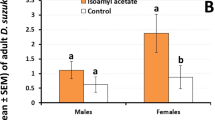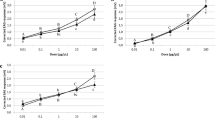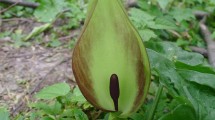Abstract
THE skin of the apple cultivar ‘Sturmer Pippin’ contains one or more chloroform-soluble volatile substances which are highly attractive to newly hatched codling moth (Laspeyresia pomonella) larvae1 . There is now evidence that the factor inducing this olfactory response is the acyclic sesquiterpene α-farnesene (Fig. 1), a compound present in the natural coating of ‘Sturmer’ as well as several other apple and pear varieties2–4. This hydrocarbon has also been isolated from the Dufour's gland of at least two5,6 and possibly more7 species of ant and Blum8 has speculated that it may have a role as a pheromone in these insects.
Similar content being viewed by others
Article PDF
References
Sutherland, O. R. W., Entomologia Exp. App.. (in the press).
Huelin, F. E., and Murray, K. E., Nature, 210, 1260 (1966).
Murray, K. E., Aust. J. Chem., 22, 197 (1969).
Meigh, D. F., and Filmer, A. A. E., Rep. Agric. Res. Coun. Ditton Laboratory, 36 (1966–1967).
Cavill, G. W. K., Williams, P. J., and Whitfield, F. B., Tetrahed. Lett., 2201 (1967).
Morgan, E. D., and Wadhams, L. J., J. Insect. Physiol., 18, 1125 (1972).
Bergström, G., and Löfqvist, J., J. Insect Physiol., 14, 995 (1968).
Blum, M. S., A. Rev. Ent., 14, 57 (1969).
Author information
Authors and Affiliations
Rights and permissions
About this article
Cite this article
SUTHERLAND, O., HUTCHINS, R. α-Farnesene, a Natural Attractant for Codling Moth Larvae. Nature 239, 170 (1972). https://doi.org/10.1038/239170a0
Received:
Issue Date:
DOI: https://doi.org/10.1038/239170a0
This article is cited by
-
Spatial distribution of Cydia pomonella (Lepidoptera: Tortricidae) populations and its relation with topographic variables
Applied Entomology and Zoology (2021)
-
Combining Mutualistic Yeast and Pathogenic Virus — A Novel Method for Codling Moth Control
Journal of Chemical Ecology (2013)
-
10.1007/BF00187843
CrossRef Listing of Deleted DOIs (2011)
-
10.1007/BF00305650
CrossRef Listing of Deleted DOIs (2011)
-
10.1007/BF00628369
CrossRef Listing of Deleted DOIs (2011)
Comments
By submitting a comment you agree to abide by our Terms and Community Guidelines. If you find something abusive or that does not comply with our terms or guidelines please flag it as inappropriate.



